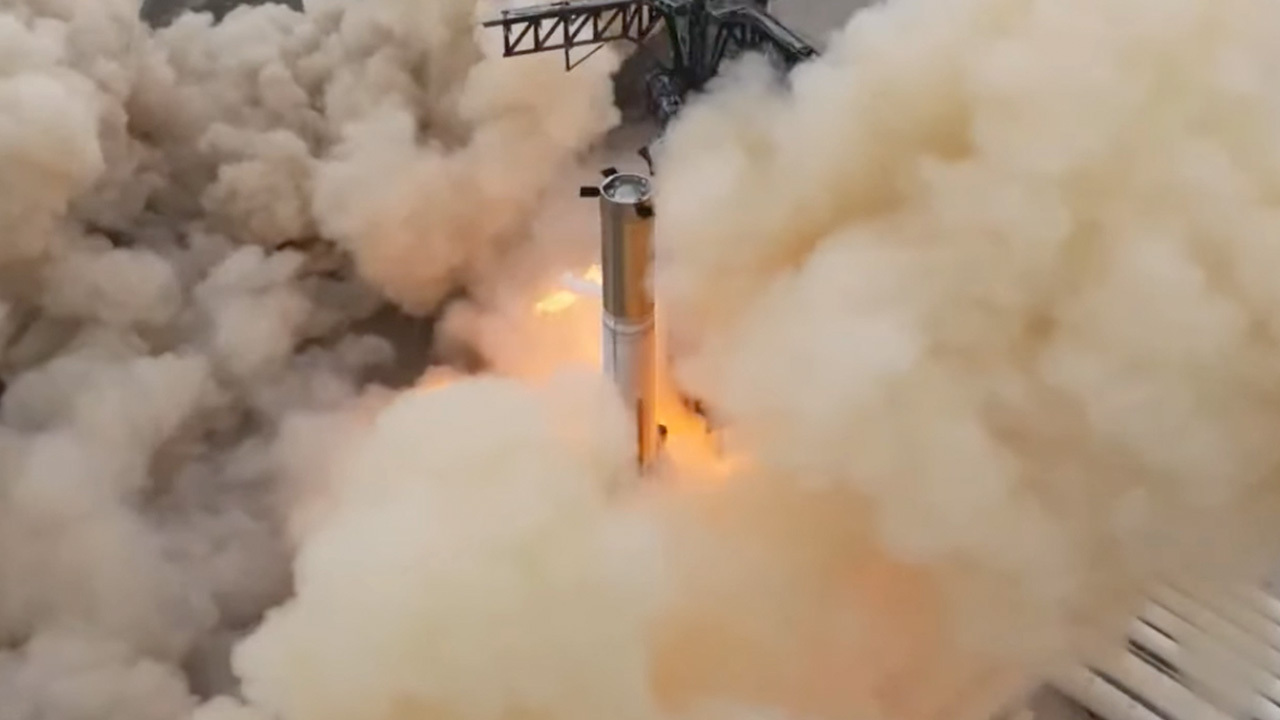SpaceX's huge Starship booster conducts historic 31-engine burn (video)
SpaceX's giant Starship vehicle just took a huge step toward its first-ever orbital test flight, which could take place as soon as next month.
A Starship first-stage prototype known as Booster 7 ignited 31 of its 33 Raptor engines during a "static fire" test today (Feb. 9) at SpaceX's Starbase facility in South Texas.
The goal was to fire all 33 Raptors during the test, which occurred at 4:13 p.m. EST (2113 GMT; 3:13 p.m. local Texas time). But SpaceX will take it.
"Team turned off 1 engine just before start & 1 stopped itself, so 31 engines fired overall. But still enough engines to reach orbit!" company founder and CEO Elon Musk said via Twitter just after the test wrapped up.
The static fire lasted about seven seconds, the duration that SpaceX had mapped out beforehand, according to the company. And Booster 7 emerged from the huge cloud of kicked-up dust in one piece, which is something to celebrate as well.
Related: SpaceX's 1st orbital Starship looks supercool in these fueling test photos
SpaceX views Starship as a potentially revolutionary transportation system, one that could make Mars colonization and other ambitious off-Earth feats economically feasible. The stainless-steel vehicle consists of two elements: A giant booster called Super Heavy and a 165-foot-tall (50 meters) upper-stage spacecraft known as Starship.
Breaking space news, the latest updates on rocket launches, skywatching events and more!
Both Starship and Super Heavy are designed to be fully reusable, and both are powered by SpaceX's next-generation Raptor engine — 33 for the booster and six for the upper stage.
For months, SpaceX has been preparing Booster 7 and a Starship prototype called Ship 24 for an orbital flight test. Such work has included a fueling test with the duo, which the company achieved on Jan. 23, and a number of static fires — prelaunch trials in which engines are ignited briefly while a vehicle remains anchored to the ground.
Ship 24 fired up all six of its Raptors at Starbase last September, for example, and Booster 7 ignited 14 of its 33 engines two months later. That was the big first stage's static-fire high until today's test, which apparently checked a crucial box on the road to an orbital attempt.
Views from drone of Booster 7's static fire test pic.twitter.com/KN4sk1nohfFebruary 9, 2023
That highly anticipated flight could occur as early as next month, provided today's test went as well as it appeared to (a verdict SpaceX won't render before analyzing all the data) and remaining checkouts go well, founder and CEO Elon Musk has said.
During that test mission, the Booster 7-Ship 24 duo will become the most powerful rocket ever to fly, taking the mantle from NASA's Space Launch System (SLS) rocket, which debuted Nov. 16 on the agency's Artemis 1 moon mission.
SLS generated 8.8 million pounds of thrust on that liftoff. Super Heavy's 33 Raptors produce about 16.5 million pounds of thrust at full power, according to SpaceflightNow.
Booster 7 will come back to Earth in the Gulf of Mexico shortly after liftoff, if all goes according to the test-flight plan. Ship 24 will circle our planet once and then splash down in the Pacific Ocean near the Hawaiian island of Kauai.
Mike Wall is the author of "Out There" (Grand Central Publishing, 2018; illustrated by Karl Tate), a book about the search for alien life. Follow him on Twitter @michaeldwall. Follow us on Twitter @Spacedotcom or on Facebook.

Michael Wall is a Senior Space Writer with Space.com and joined the team in 2010. He primarily covers exoplanets, spaceflight and military space, but has been known to dabble in the space art beat. His book about the search for alien life, "Out There," was published on Nov. 13, 2018. Before becoming a science writer, Michael worked as a herpetologist and wildlife biologist. He has a Ph.D. in evolutionary biology from the University of Sydney, Australia, a bachelor's degree from the University of Arizona, and a graduate certificate in science writing from the University of California, Santa Cruz. To find out what his latest project is, you can follow Michael on Twitter.

